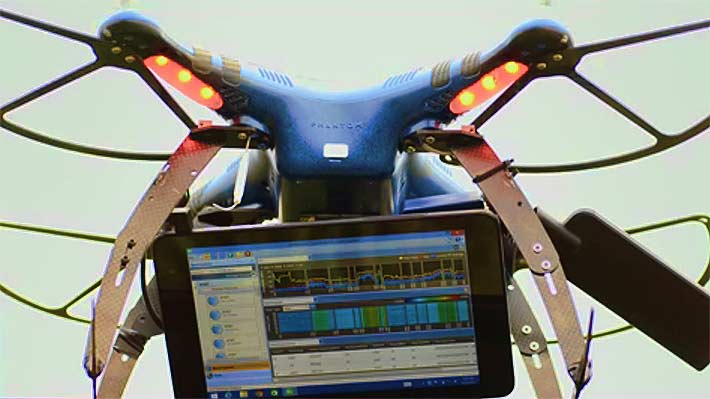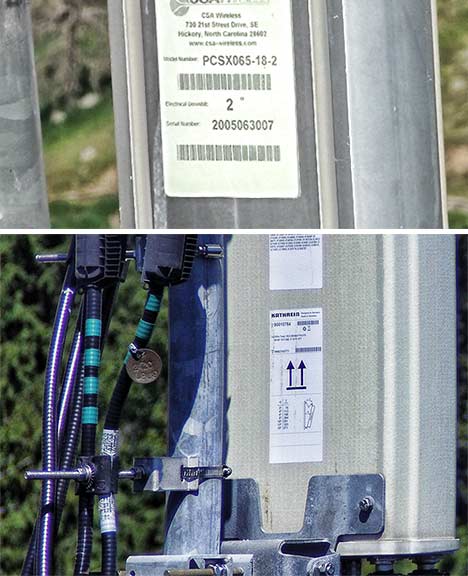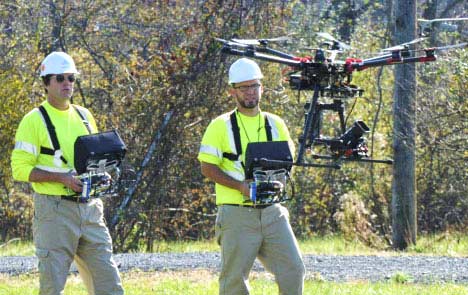
Tremendous technology advances now allow drones to provide asset tags, 3-D CAD modeling, signal analyzing, thermal imaging, line-of-sight testing and other real-time tasks that can be easily viewed by the client.
In 2013, when Amazon unveiled its daring drone plan to have unmanned aircraft systems (UAS) provide commercial deliveries, Black & Veatch had already been investigating how drones could assist in reducing the number of times climbers would have to ascend a tower.
At an FCC-OSHA workshop in 2014, John Johnson, Black & Veatch Vice President, ESH&S, said, “I know that the drones aren’t going to hang the antennas, not going to turn the wrenches, not going to pull the cables.” But he emphasized, “If we can have a drone go up and help plan the work and validate what is exactly on that tower so the climber climbs once, not two, three, four times, that type of technology needs to be explored, utilized and can help.”

These assets were photographed from over 20 feet away from the tower, allowing for equipment views that can’t always be photographed while a climber is safely tied off to a tower. UAS operators also state that the elevations they provide are considerably more accurate than the traditional tape drop.
And although drones have been marginally used for mapping structures and other wireless applications over the years, advances in software, drone and optics technology, and most recently, a set of guidelines and objectives passed by the US Senate last week that Wireless Estimator has made easily viewable, will most likely see an accelerated use of UASs within the industry, if the U.S. House of Representatives passes the Federal Aviation Administration (FAA) Reauthorization Act of 2016.
A number of industry professionals who have been pouring over the lengthy document believe that it could kick-start renewed interest in using the available UAS providers, who will readily admit that acceptance by tower owners, carriers, site planners and contractors has been minimal.
“We can show that, just in tower mapping alone, our software will be far more accurate and more capable of capturing information that can be provided by a tower climber, and at a considerably less cost,” said one UAS company executive who requested anonymity. UAS software systems can project accuracy of tower assets to within a millimeter.
“What I like about the bill [S.2658] is that it provides opportunities to develop and have the FAA review new avenues for advancing how we can assist the industry. For years it has been the Wild West and this will provide the many answers and structure that has been needed.”
Another knowledgeable UAS executive said off the record that he was very pleased with the bill, citing the FAA’s ability to approve nighttime and beyond-line-of-sight operations.
“Operating beyond line of sight will really open up the commercial UAS industry, but there are some major security, privacy, and safety issues that will first have to be resolved,” he said.
NATE applauds the bill’s passage
The National Association of Tower Erectors (NATE) on Friday commended the U. S. Senate for approving language to enhance education and safety in the use of UASs.
“The Association is extremely interested in the commercial application of Unmanned Aerial Systems technology. UAS can complement and enhance the safety and well-being of communication tower workers by minimizing the risks associated with climber fatigue, weather, and distractions, while reducing repetitive stress injuries. Moreover, they can cut costs and promote efficiency while assisting with tower inspections and surveys,” said Executive Director Todd Schlekeway in a statement.
Schlekeway also noted that NATE has been working closely with the Occupational Safety and Health Administration, the Federal Communications Commission, and the National Telecommunications and Information Administration on a variety of tower industry safety initiatives.
NATE Chairman Jim Tracy from Legacy Telecommunications, Inc. also praised the U.S. Senate, particularly for provisions requiring all users of UAS to not only be familiar with federal rules, but to also be required to pass a safety test. “The bill’s emphasis on education and safety in the use of technology is consistent with NATE’s status as a national leader in developing and implementing tower safety programs,” said Tracy.
AT&T is already tied tightly to drones
It is likely that AT&T will view the bill as a positive for its drone-related endeavors since it needs the ability for drones to be operated beyond line of site to support its Intenet of Things programs. Last February, the carrier announced that it had teamed up with Intel to evaluate the performance of their network at higher altitudes. The company said they would be testing to see “how it affects video streaming, transmitting telematics and flight information.”
“This engagement pushes the boundaries in the UAV industry and will pave the way to a connected world in the Internet of Things,” said Anil Nanduri, vice president of the New Technology Group and general manager of New Markets within the Perceptual Computing Group at Intel. “Intel believes UAVs have great potential, from inspections, precision agriculture to deliveries of consumer goods and providing emergency disaster relief. We want to grow this market through our collaborations and by integrating new technologies and compute to UAVs.”
AT&T has five approved UAS companies: ETAK Systems, Hazon Solutions, Montico, RKC Site Solutions, and Talon.
It’s no longer your grandfather’s drone or software
In the analog build-out days, shooting multiple SLR camera photos was the only way that carriers could ensure that their equipment had been installed as required, and it wasn’t uncommon to see a project manager dropping off canisters of film at a drive-through Fotomat kiosk.
Around 1998 when digital cameras became affordable, it was difficult to appreciate how that technology could ever be supplanted. Five years later more camera phones were sold worldwide than stand-along digital cameras and in the past three years a number of apps have streamlined the closeout photo/document process.
However, tremendous drone, camera optic and software advances are now capable of providing asset tags, 3-D CAD modeling, signal analyzing, thermal imaging, line-of-sight testing and other real-time tasks that can be easily viewed by the client.
Although there are UAS companies every day getting their FAA 333 exemption for U.S. commercial drone pilots, and they have 200 drone manufacturers to choose from to obtain their aircraft, it will most likely be the companies that employ the best software packages for the wireless industry that will be the most successful – providing they have the other requisite capabilities that clients will require.
Repack program could be an indicator of drone acceptance
The ambitious 39-month deadline for TV broadcasters to complete their spectrum ‘repacking’ obligations once the FCC’s reverse auction is completed, could see a greater interest in the use of drones to map structures and tag assets to ensure a quicker turn-around in an industry that – in most professional circles – doesn’t have enough qualified tall tower crews.

Duke Dietz, left, and Sean Cushing of Hazon Solutions demonstrate their company’s capabilities to managers of Dominion Power & Light in Virginia.
The FCC released a ruling on April 18, 2016 that repacking expenses incurred before or during the upcoming broadcast incentive auction, such as tower mapping, whether it’s done by tower crews or drones, and structural analysis expenses, will be compensated by the FCC so long as they are covered repacking-related expenses and the TV station has to move to a new channel in the repack.
“The use of UASs in respect to the repack project is essential to provide the safest and most informed decisions. The UASs can offer real time assessments at heights and detect potential life-threatening faults that would not otherwise be seen,” said Phil Larsen, President of HAZON Solutions Telecommunications Services.
Although the current regulations require drones to be flown below 500 feet, numerous focus groups are requesting that authorized and approved UAS companies will be able to request Class T airspace authorization since tall tower locations are already recognized as a no fly zone by the FAA for manned aircraft.
“The technology and the capability by experienced and authorized UAS companies is there to be used and should be,” said Larsen, who also stated that the repacking program could be advanced and completed on time if engineers knew what their structure was capable of handling, and what transmission systems needed to be removed.
T-Mobile and ERI have the perfect opportunity and finances to put UASs in play
Industry eyes will be focused on T-Mobile and antenna manufacturer Electronics Research, Inc. (ERI) to see if they take advantage of UAS support as part of their partnership to accelerate the process of clearing the 600 MHz frequency band within the FCC’s 39-month repacking timeline. Earlier this month, T-Mobile said it was going to partner with ERI so that the Indiana company could increase their manufacturing capabilities by 800% and increase their tall tower crew count.
Johnson, trade groups and UAS companies stress that drone technology will never replace tower climbers, and they’re correct, but it will take away some business from companies that rely upon their mapping services to carriers and tower owners.
“There are always trade-offs in any industry as technology evolves,” said a UAS executive. “As an example, there were many companies years ago that solely provided sweep tests to carriers, but that changed as test equipment became less expensive and training was minimal. Today, almost all contracts require crews to provide those services.”
















